Biology > QUESTIONS & ANSWERS > Inpatient Obstetrical Certification NCC (All)
Inpatient Obstetrical Certification NCC
Document Content and Description Below
Inpatient Obstetrical Certification NCC Leading cause of perinatal admissions to the ICU Correct Answer: Hemorrhagic disorders Percentage of deaths related to pregnancy related hemorrhages Cor... rect Answer: 17-25% Most maternal deaths from obstetric hemorrhage after first trimester of pregnancy are due to Correct Answer: Placental abruption Race most likely to die from post-partum hemorrhage Correct Answer: African Americans Mortality rate (2006) for white women, African American women and Hispanic women in the US, stated as deaths per 100,000 live births Correct Answer: White women 13.3/100,000 African American women 32.7/100,000 Hispanic women 10.2 68% of post-partum hemorrhage deaths occur within _______hours of delivery Correct Answer: 48 Obstetric hemorrhage is defined as a TBL or more than Correct Answer: 1000cc The classic sign of placenta previa is Correct Answer: painless vaginal bleeding in the second or third trimester of pregnancy If you see painless vaginal bleeding in the second or third trimester of pregnancy, suspect Correct Answer: Placenta previa Risk factors for placenta previa Correct Answer: previous placenta previa, advanced maternal age greater than 40, previous cesarean, short interval between pregnancies, multiparity,previous abortions with curettage, smoking, race (Asian women at greatest risk), large placenta In patients with suspected placenta previa, which comes first, a speculum examination or a confirmatory ultrasound? Correct Answer: Do the ultrasound first Fetal blood volume is Correct Answer: 100ml/kg Changes noted during significant blood loss Correct Answer: Rising pulse rate Increase in respiratory rate Skin changes to pallor Falling blood pressure (a late finding) Decreased urinary output Decreased LOC Characteristic findings in FHR if mother has a significant blood loss Correct Answer: Initially, tachycardia Then bradycardia Sinusoidal-fetal anemia, hypoxia and academia Persistent late decelerations Percentage of accreta among women with previa Correct Answer: 5-10% If patient has had 2 or more cesarean sections, the likelihood of an accreta is Correct Answer: Greater than 50% Vasa previa Correct Answer: Fetal vessels cross the placental membranes in the lower uterine segment and cover the cervical os Velamentous cord insertion Correct Answer: Fetal vessels run across chorion and amnion without protective Wharton's jelly before entering the placental surface Succenturiate placenta Correct Answer: One or more small accessory lobes of placental vascular tissue in membranes that are attached to main placenta by fetal vessels Hemolysis Correct Answer: lysis of erythrocytes with the release of hemoglobin HELLP Correct Answer: Hemolysis, Elevated Liver Enzymes, Low Platelets Per AWHONN, patients with placenta previa should not be discharged to home until they have gone_____hours with not bleeding Correct Answer: 72 hours Classic symptom of placental abruption Correct Answer: Painful vaginal bleeding after 20 weeks gestation Risk factors for placental abruption Correct Answer: Smoking increases risk 90% Maternal hypertension 500% increased risk Multiparity Abortions Illicit drug use Short umbilical cord Abdominal trauma Rupture of membranes(due to sudden uterine decompression) Leiomyoma behind placenta ACOG standard for fetal monitoring for maternal abdominal trauma Correct Answer: Minimum of 2-6 hours DIC stands for Correct Answer: disseminated intravascular coagulation DIC is Correct Answer: a pathologic form of clotting that is diffuse and consumes large amounts of clotting factors, causing widespread external or internal bleeding or both Specific diagnostic test for DIC Correct Answer: D-dimer is positive in 34% of cases of DIC Gestational Trophoblastic Disease Correct Answer: condition in which trophoblastic tissue overtakes the pregnancy and propagates throughout the uterine cavity Hydatidiform mole is characterized by Correct Answer: chronic or acute bleeding and a uterus that is large for gestational age. 1 in 1200 pregnancies. 5% turn into choriocarcinoma Preeclampsia in the first trimester, HCG levels above 100,000 mIU/mL, and an enlarged bleeding uterus are clinical signs of what? Correct Answer: Hydatidiform mole Five groups of hypertensive disorders in pregnancy Correct Answer: 1. Gestational hypertension-hypertension developing after 20 weeks gestation without proteinuria 2. Preeclampsia-hypertension developing after 20 weeks gestation with proteinuria 3. Eclampsia--Seizure activity or coma in patient with eclampsia 4. Chronic hypertension 5. Preeclampsia superimposed on chronic hypertension _______% of women with preeclampsia develop HELLP syndrome Correct Answer: 5 Initiate antihypertensive if BP > 160/110. List top drug choices, in order of AWOHHN preference Correct Answer: Hydralazine Labetalol Nifedipine How long does it take before the lung maturity benefits of betamethasone are seen? Correct Answer: 24 hours after administration Magnesium sulfate toxicity can occur rapidly. Toxicity could result in impaired_______function. Correct Answer: Renal function--always use a urimeter ______% of eclampsia and HELLP cases occur after delivery Correct Answer: 30 TORCH is an acronym for Correct Answer: Toxoplasmosis, Other (hepatitisB), Rubella, CMV, Herpes SGA Correct Answer: Small gestational age; growth is below 10th percentile IUGR from placenta insufficiency usually reduces ___________more than _______. Correct Answer: birth weight length Which is more ominous, symmetrical or asymmetrical growth restriction? Correct Answer: Neonates with symmetrical growth restriction have the poorest long-term prognosis and commonly have chromosomal abnormalities; postnatal nutrition is unable to correct for growth deficits: symmetrically grown SGA babies may never catch up in size when compared to unaffected babies Growth restriction at less than 28 weeks is generally (symmetrical or asymmetrical) in nature. Correct Answer: Symmetrical. Infants are symmetrically grown and all organ systems are small. Much more ominous than asymmetrical growth restrictions. Growth restriction at more than 28 weeks is general (symmetrical or asymmetrical) in nature. Correct Answer: Asymmetrical. This type of infant has a better prognosis than one who is symmetrically IUGR. Optimal postnatal nutrition generally restores normal growth potential because the number of body cells is normal. LGA Correct Answer: Large for Gestational Age. Having a birth weight greater than the 90th percentile on intrauterine growth charts. Caput succedaneum Correct Answer: is a localized, easily identifiable, soft area of the scalp, generally resulting from a long and difficult labor or vacuum extraction. Extra fluid should be reabsorbed within 12 hours after birth. Crosses suture lines. Cephalohematoma Correct Answer: a collection of blood between the periosteal membrane and a skull bone. Caused by rupture of capillaries from the pressure of birth. No pressure on brain, takes 3-6 weeks to resolve Postterm Correct Answer: Delivery after 42 weeks gestation Transition is Correct Answer: Transition is a response, in part, to the increased level of oxygen in the circulation once air breathing has begun; if oxygen levels remain low, the fetal pattern of circulation may persist, causing blood flow to bypass the lungs. Fact--Preterm infants may have impaired regulation of blood pressure in the face of apnea, bradycardia, and mechanical ventilation. Correct Answer: Resulting fluctuations in cerebral blood flow are common. These fluctuations predispose the fragile blood vessels in the brain to rupture, causing intracranial hemorrhage. Fluctuations in blood pressure can cause loss of brain blood flow, resulting in ischemia. These fluctuations also predispose the preterm infant to develop retinopathy of immaturity. Fact--Procedure to follow if meconium is present in the amniotic fluids: Infants who are depressed at birth or make poor attempts to take the first breath should be intubated in the delivery room and suctioning of the trachea should occur to remove meconium below the vocal cords. Infants who attempt to breathe and clear their own airway should be allowed to do so without intervention. Correct Answer: Approximately one third of infants with meconium below the vocal cords become ill and require intensive care. [Show More]
Last updated: 1 year ago
Preview 1 out of 11 pages

Reviews( 0 )
Document information
Connected school, study & course
About the document
Uploaded On
May 21, 2022
Number of pages
11
Written in
Additional information
This document has been written for:
Uploaded
May 21, 2022
Downloads
0
Views
56



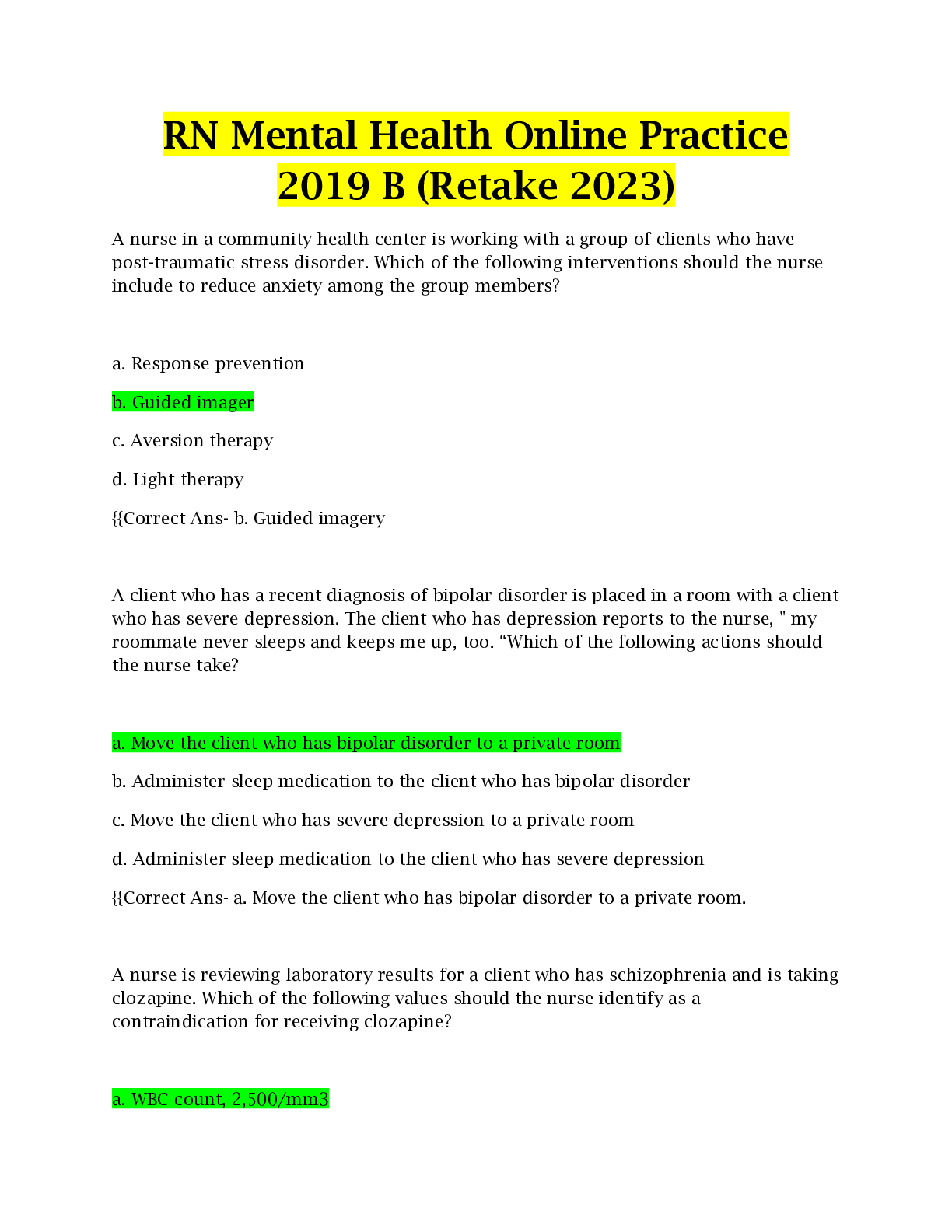




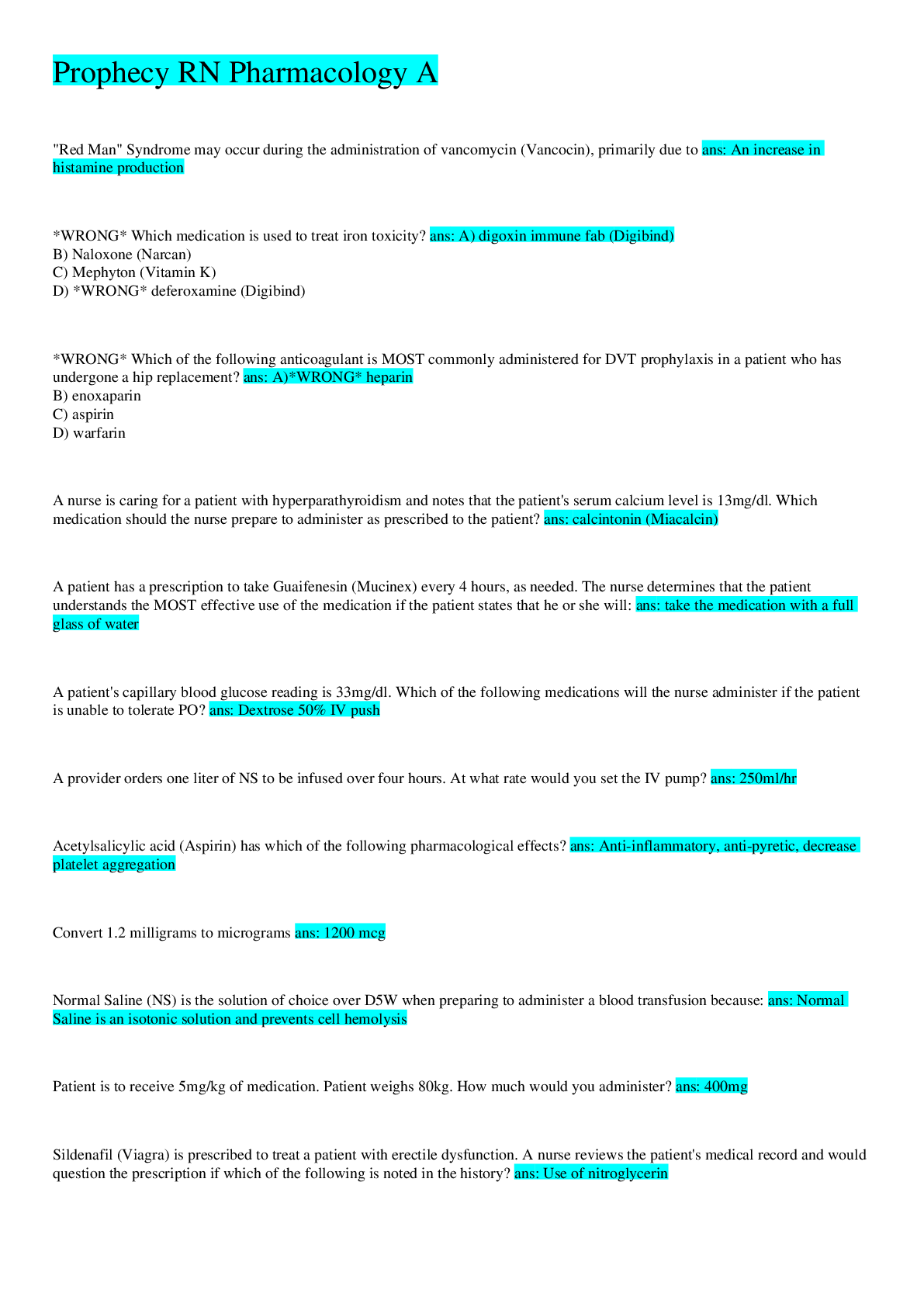

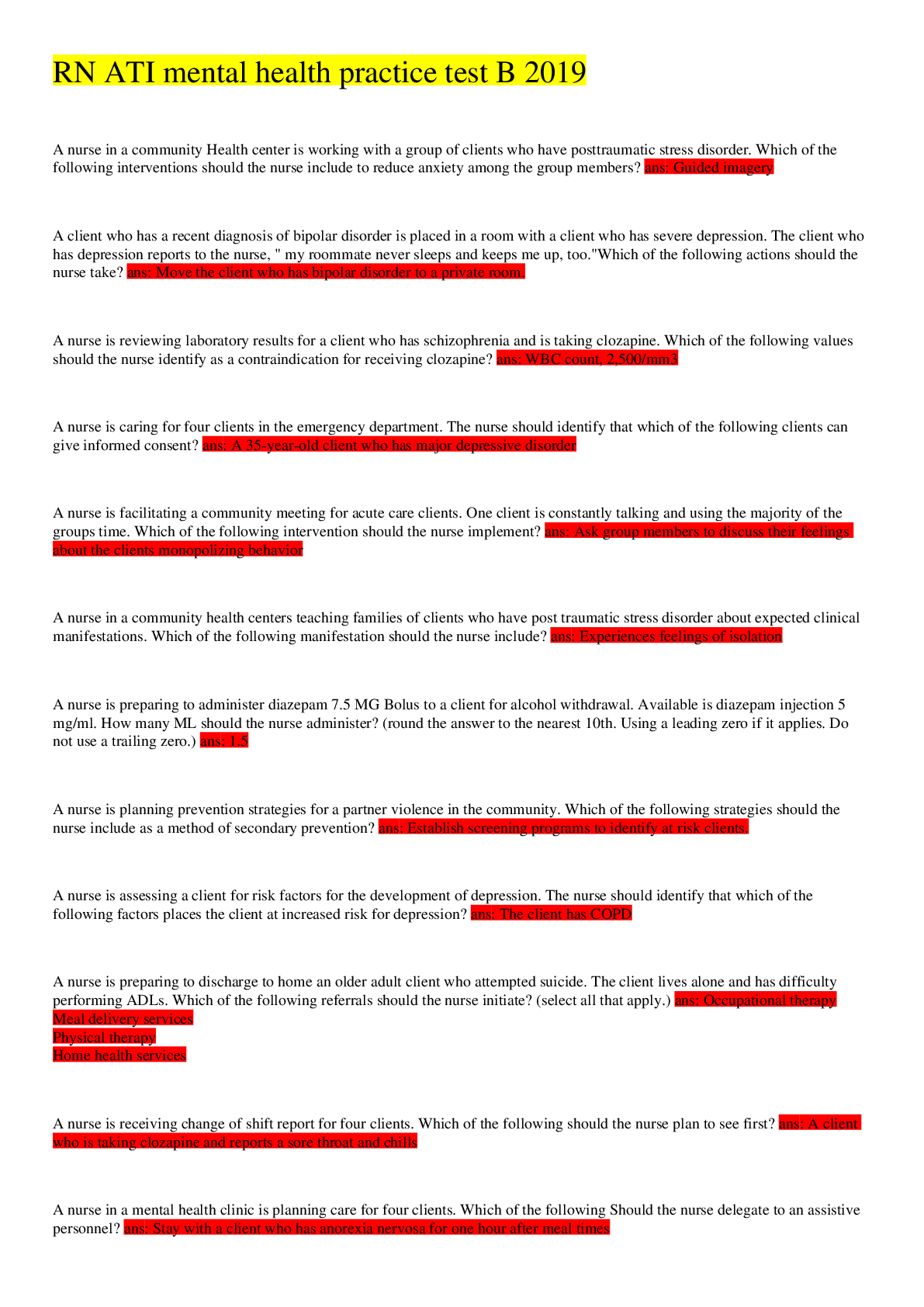
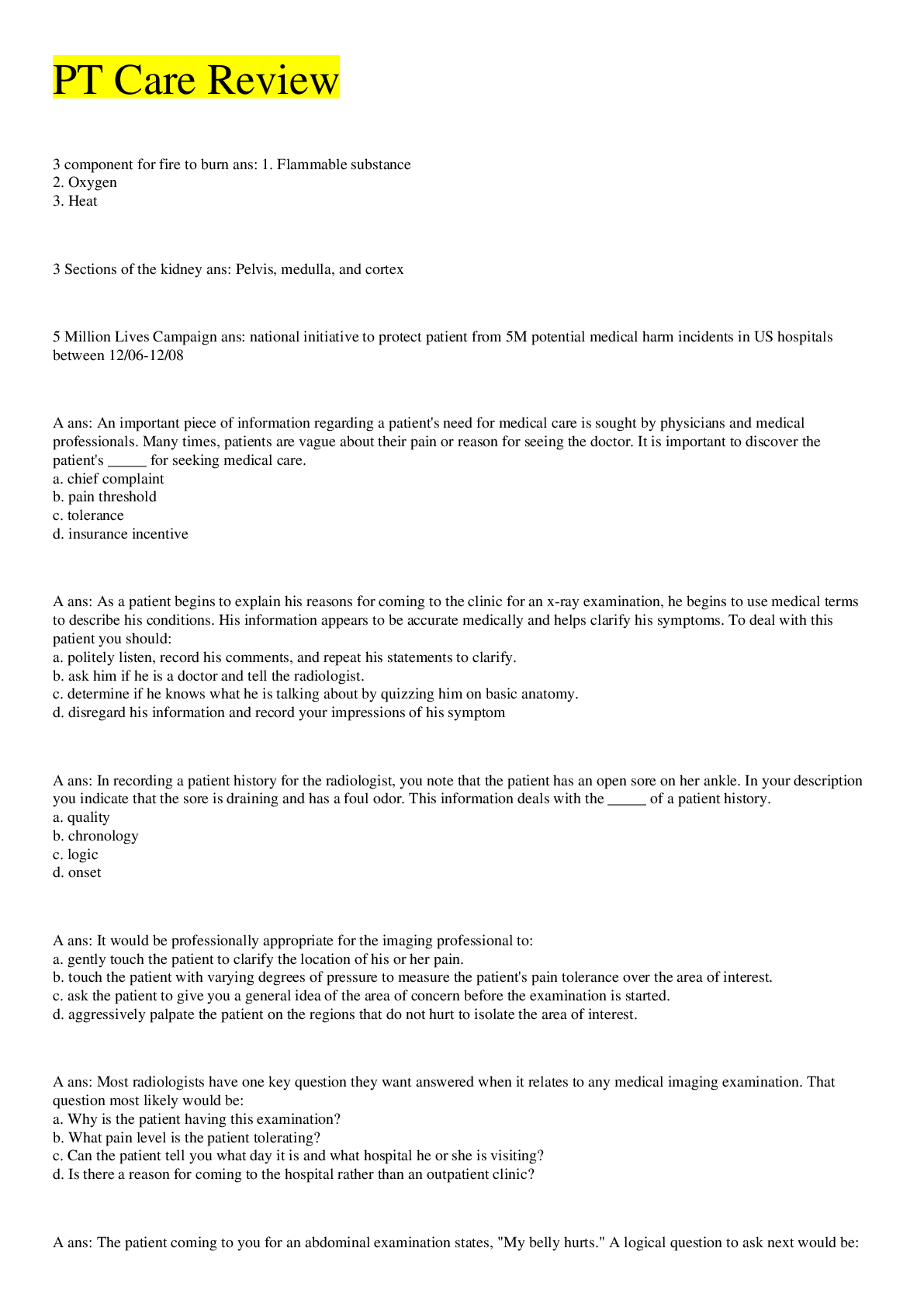

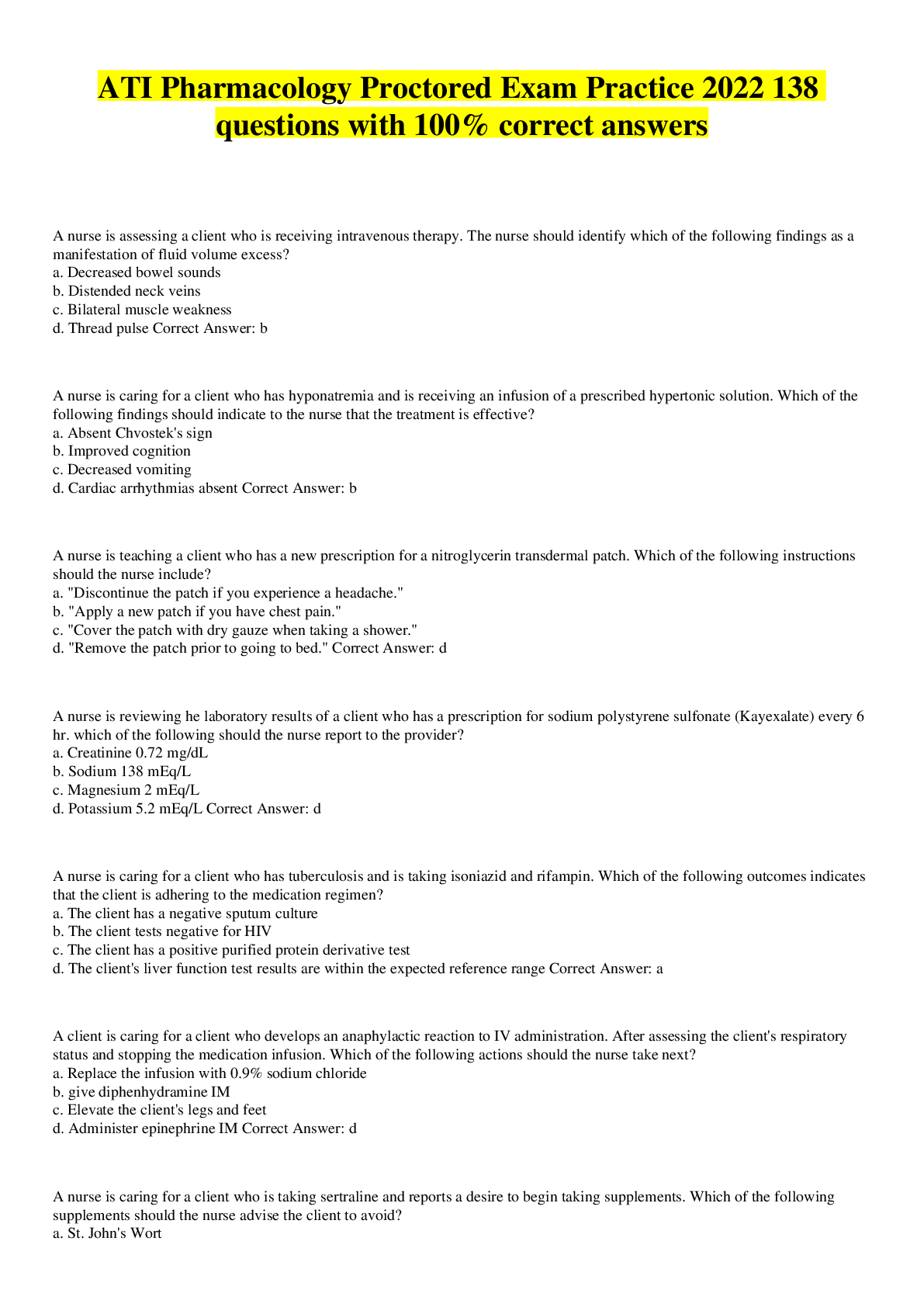
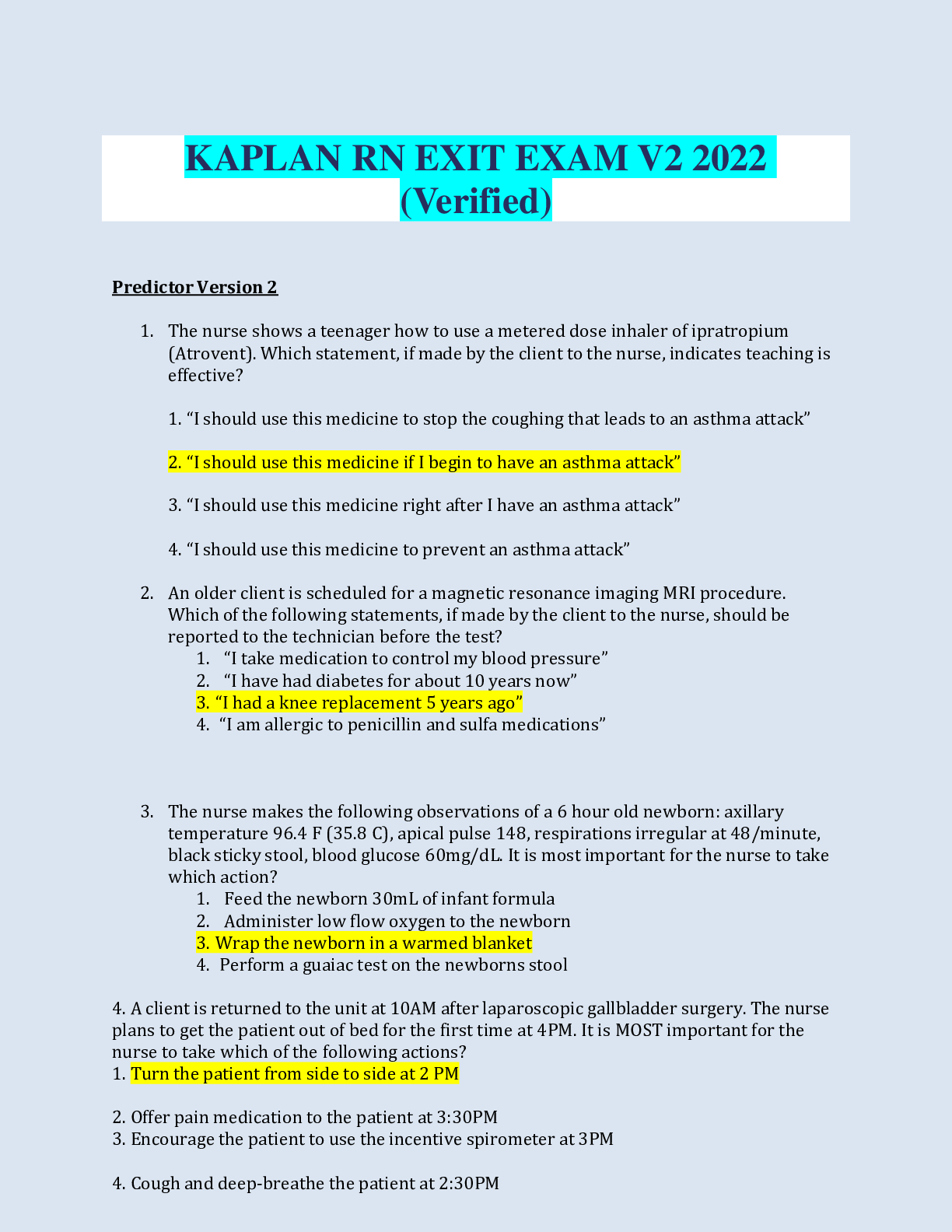


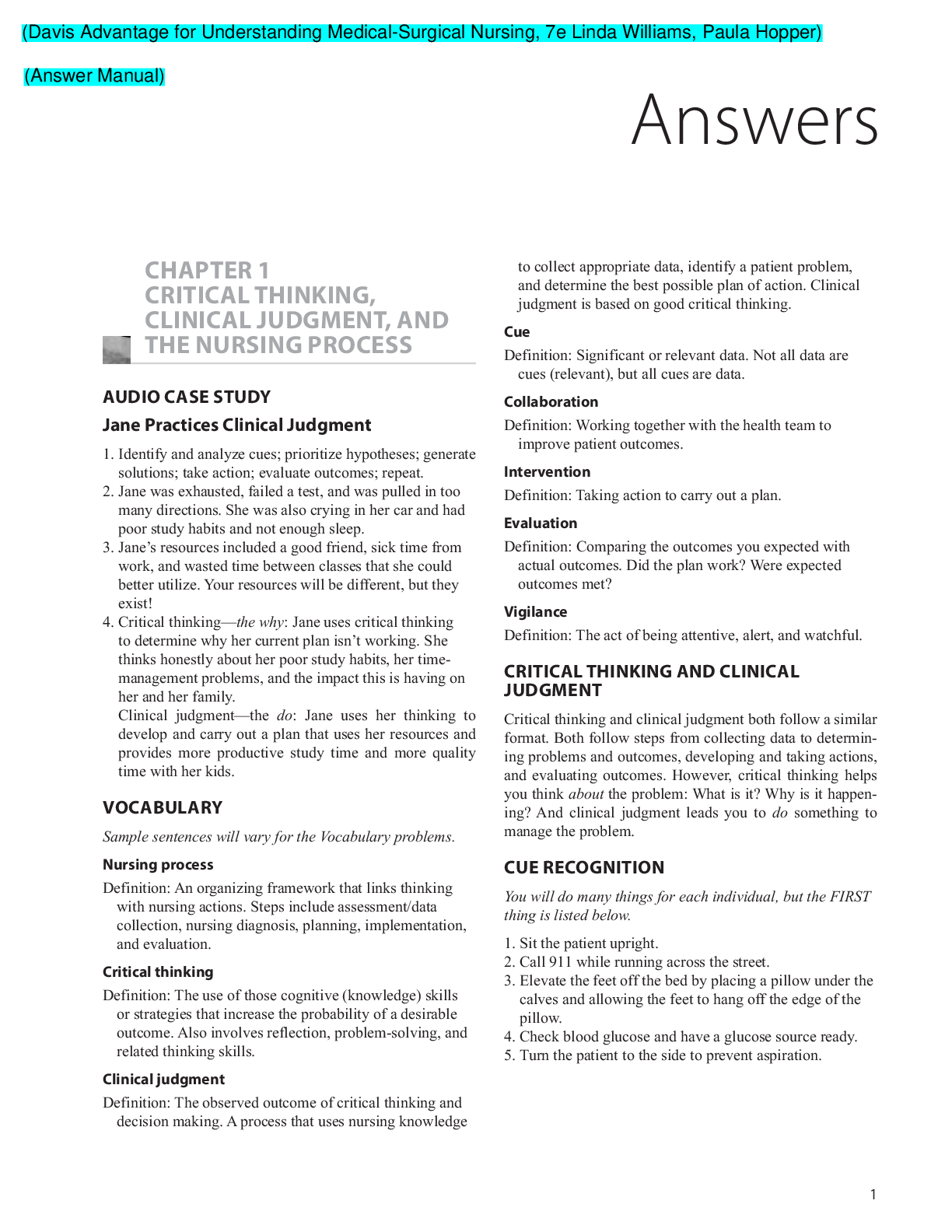

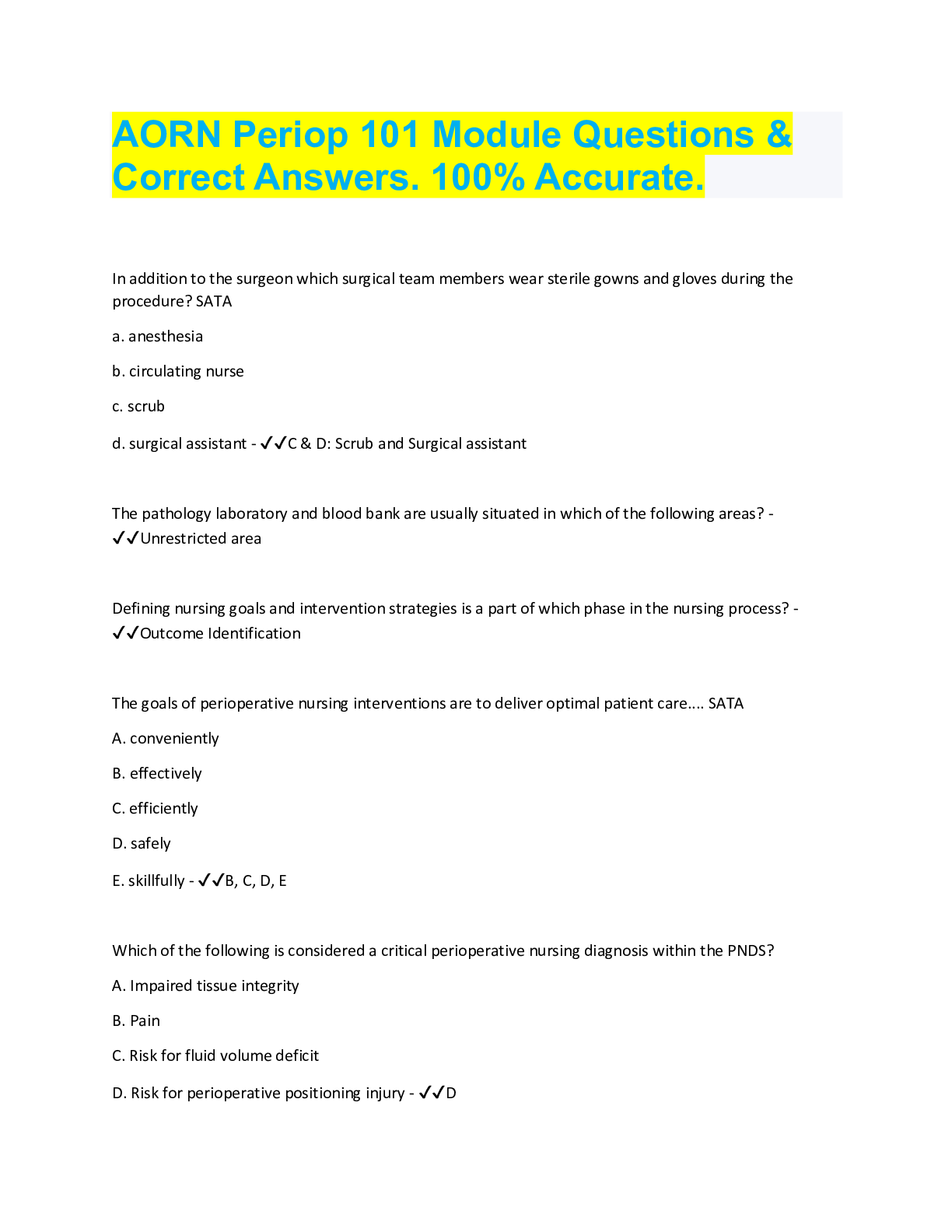






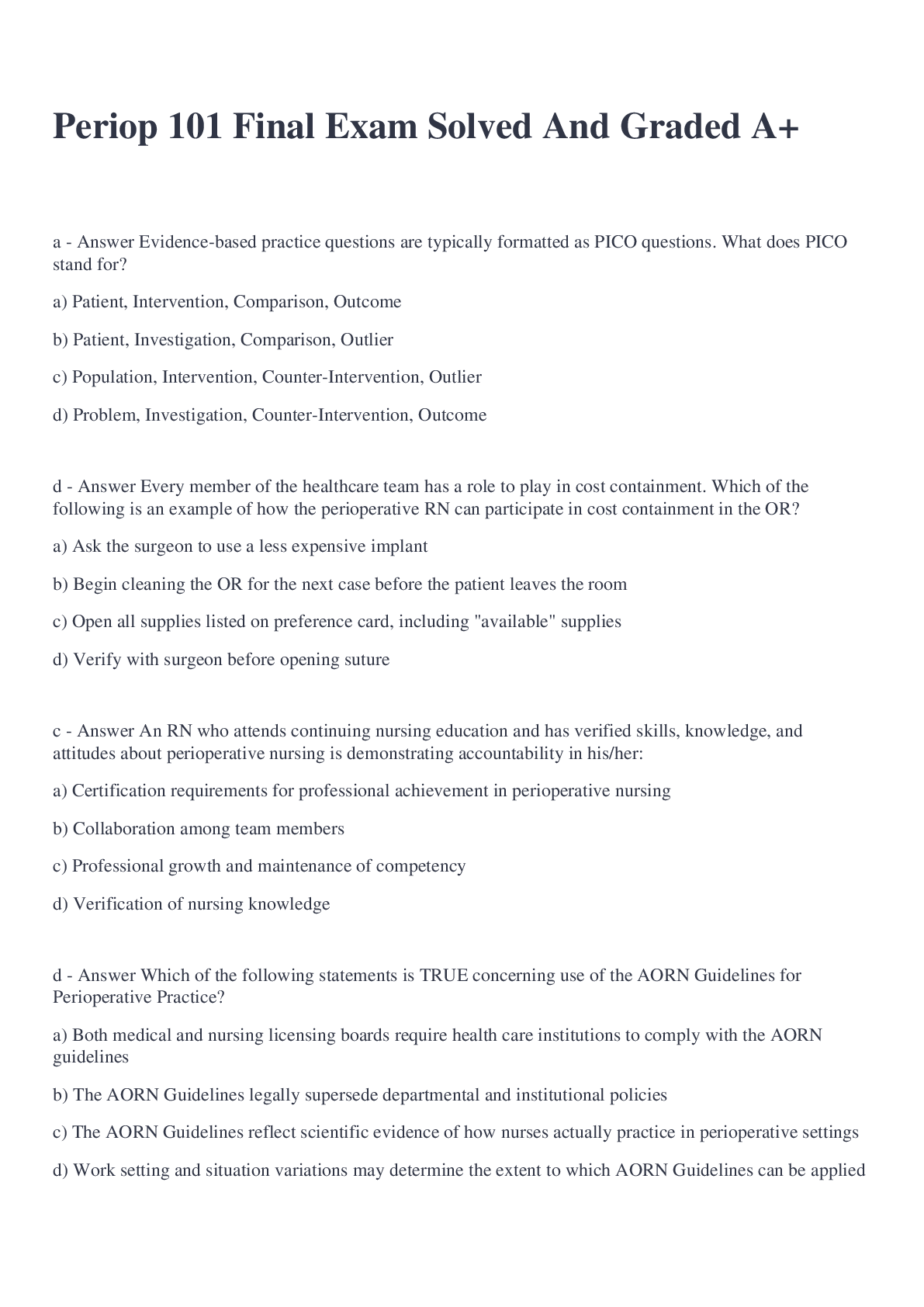


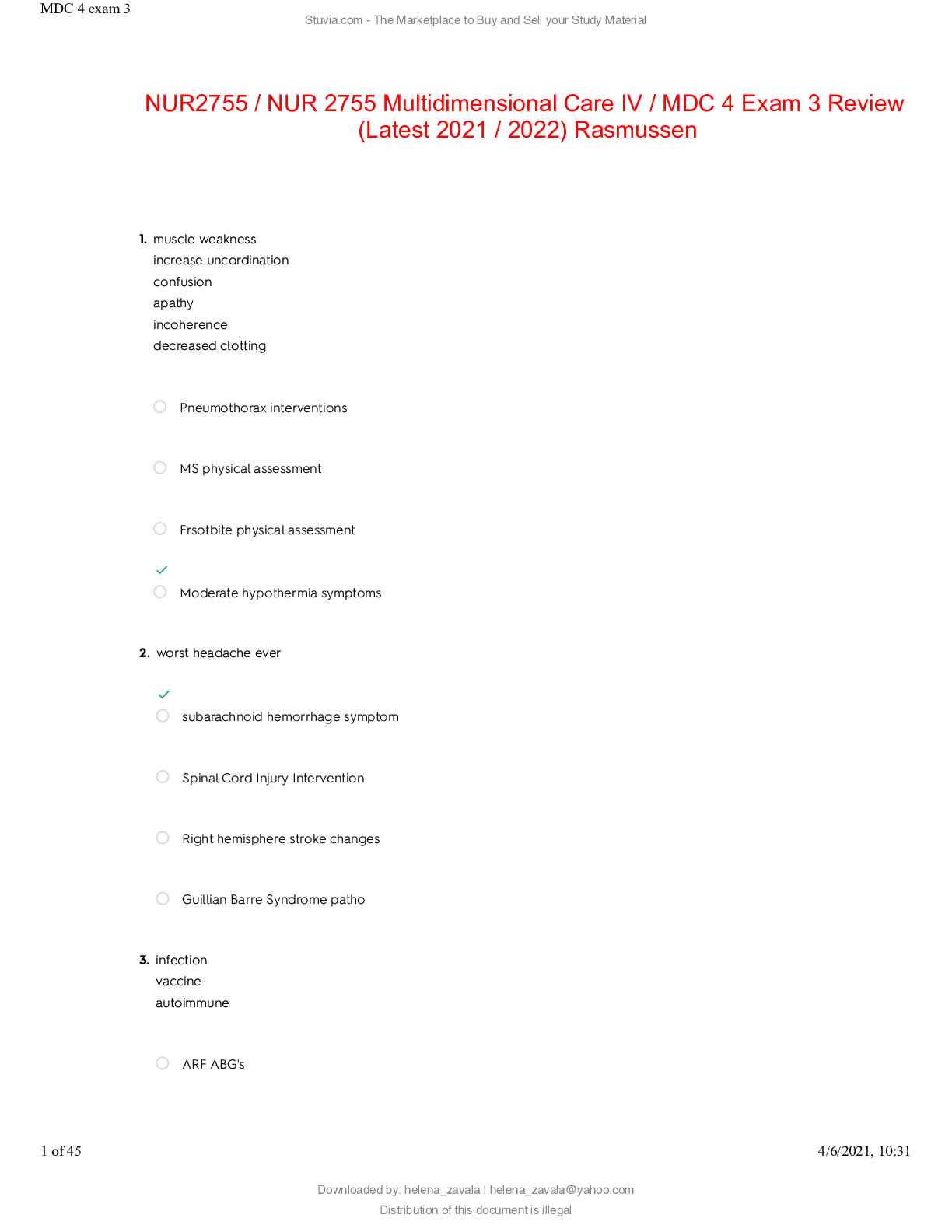


.png)

